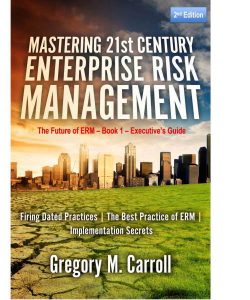Artificial Intelligence (AI) for risk-based decision-makings
How Artificial Intelligence (AI) can supercharge risk-based decision-making. By applying AI techniques to Scenario Analysis, you can identify the effect of current events on your strategic and tactical objectives.
Previously I stated: “if your Enterprise Risk Management system (ERM) can’t tell you where you are now, AFTER an event like Brexit, COVID or a cyberattack, it’s a failure!” You cannot make prudent business decisions in a state of uncertainty. Your risk registers and risk matrix ratings are of no use in deciding the best way forward. But Artificial intelligence offers that opportunity.
Scenario Analysis identifies paths to potential outcomes

The Secret to Risk based Decision Making is Scenario Analysis
In “Mastering 21st Century Enterprise Risk Management” I recommend you develop a series of scenario analyses for potential risk events that can effect to your strategic and tactical objectives. By the way, scenario analysis, as practices in financial modelling, is not scenario analysis, but “what-if” analysis on a possible outcome. Scenario analysis involves working out the path events might take in arriving at a possible outcome. Against these, you apply risk drivers/influences that affects that path along the way. The advantage of scenario analysis is that it is not based on specific causes or consequences as in traditional risk register based systems. Instead, It looks at how an objective can change and how those changes can come about.
This means instead of you having to predict events, scenario analysis allows you to predict the most likely outcome, given the current circumstances. So whether due to Brexit, pandemic, or cyberattack, the same scenario analysis will allow you to interrogate alternative courses of action from this point forward, i.e. a real risk-based decision-making tool. Having pre-prepared scenario analyses for possible outcomes allows for rapid response to the disruptions that mark today’s new normal. Just as COVID is not going away and we will need to learn to live with it, so too is today’s market volatility. Disruption breeds disruption in a continuing cycle. Staying ahead of this curve will be the mark of a successful business.
Building Risk Scenarios
You may ask, is not developing future scenarios the same as predicting causes or consequences? The answer is no. As covered in my earlier book, you start with the objective and consider the best, worst, and current/likely outcomes. You then identify what factors (risk drivers) can affect those outcomes, e.g. the paths to revenue are via price and volume. Working backwards, you then look to the risk influence KRIs that can affect those risk drivers, along with the strategy decision points. Continuing backwards you build a network model of the scenario.
Using Bayesian joint and conditional probabilities, you can calculate the probability of the overall outcome on the targeted strategic or tactical objective. There is no need to predict the cause of the movement of risk driver or influence. You have stated the possible outcomes for an objective. I also recommend that besides best and worst scenarios, you produce intermediate options of “getting-better” and “getting-worst”. For more information on how to develop risk scenarios, please refer to my afore-mentioned book.
Using AI for risk-based decision-makings
So how can AI assist you to assess the risk that current events pose to your objectives? There are two well proven AI technologies, when applied a scenario analysis, can identify the most likely effect current events will have on your operational, tactical, and strategic objectives. Not subjective guesses, by proven data driven processes.
You apply Knowledge Graphs to your pre-prepared scenarios, and feed them into an AI “Recommender System”. This model will advise you on the mostly like effect on the outcome of your objectives.
Knowledge Graphs, which Gartner rates as one of the top 10 AI technology that will transform the 2020s, is a technique that analyses networks to identify relationships between items and best route between two points. Google Maps uses this technique to identify the quickest (not shortest) route between two points.
Recommender Systems are AI models that, based on multiple factors including your history, market trend, and other similar cases, identify best outcomes. Such systems are in use by Facebook, Amazon and Netflix to recommend friends, products or movies you might like. They have proven very adept in predicting likelihoods based on Knowledge Graphs.
In my up-coming book “AI Based Risk Management – The Future of ERM”, I will cover other ways of applying Artificial Intelligence (AI) to risk-based decision-making. This is in addition to using these to weaponize scenario analysis. But for now, I can’t stress strongly enough, the need to develop scenario analysis for your strategic and tactical objectives. After all, ISO 31000 defines risk as the uncertainty on business objectives. And scenario analysis is how you link events to objectives.
For more on developing a risk management system based on risk events and risk drivers, have a look at “Mastering 21st Century Enterprise Risk Management”. It covers how to develop risk scenarios using network mapping and Bayesian statistics. I also cover setting up “Horizon Scanning” to monitor risk drivers in real-time that will make your ERM proactive. Not only will this provide you with a risk based decision-making tool, but will prepare you to exploit the benefits that AI and related disruptive technology will afford to the lucky few.




